
How to Keep Succulents Colorful
How do you keep a succulent that's red, orange, pink or yellow from turning green? Here's why they "revert," and how to keep them colorful.

Aeonium 'Garnet'
When a succulent is "well stressed," it has gone from green, blue-green or blue-gray to shades of red, orange, yellow, rose or purple. "Stressing" a succulent doesn't harm it, but rather enables the plant to show the colors it's capable of.
Stressing happens naturally yet is also an art form. You can stress plants deliberately, but you don't want to overdo it. Here I explain what you need to know and to expect.
Whether you can make a succulent "color-up" depends on your region, climate, the season, type of plant, and where it's located in your garden. Sun is essential; stressing is difficult to do indoors.
Scroll down for a gallery of 50 different succulents, that shows you how each looks before and after stressing. A case in point is Aloe nobilis, below.

Aloe nobilis. Left: In winter (cool temps, bright shade). Right: In summer (full, hot sun).
Certain succulents routinely color-up in summer and revert to green in winter, after the weather cools and the rains return.

Above: Kalanchoe luciae in bright shade with two hours of full sun daily. Given all-day sun (below), it turns bright red and leaves are smaller.
Not surprisingly, when confronted with too much sun, a succulent tightens up to protect its vital inner core. Learn more about how succulents respond to sun here on my site: How Much Light Do Succulents Need?

Kalanchoe luciae, fully stressed (very little green in leaves)
Which Ones color-up?
Not all succulents turn color. Most aloes and crassulas will stress beautifully, but only a few kinds of kalanchoes, echeverias, euphorbias, sempervivums, sedums, aeoniums and echeverias also do so.
Agaves typically don't, but they may redden when dying, as shown by the flowering specimens below.

Agave desmettiana 'Variegata' in bloom
When stress is too much
Most succulents---especially those with fat, fleshy leaves---can last weeks and sometimes months without water, even in hot sun, nipped by frost, and/or rooted solely in gravel. But eventually they'll need a respite, lest stress turn life-threatening.
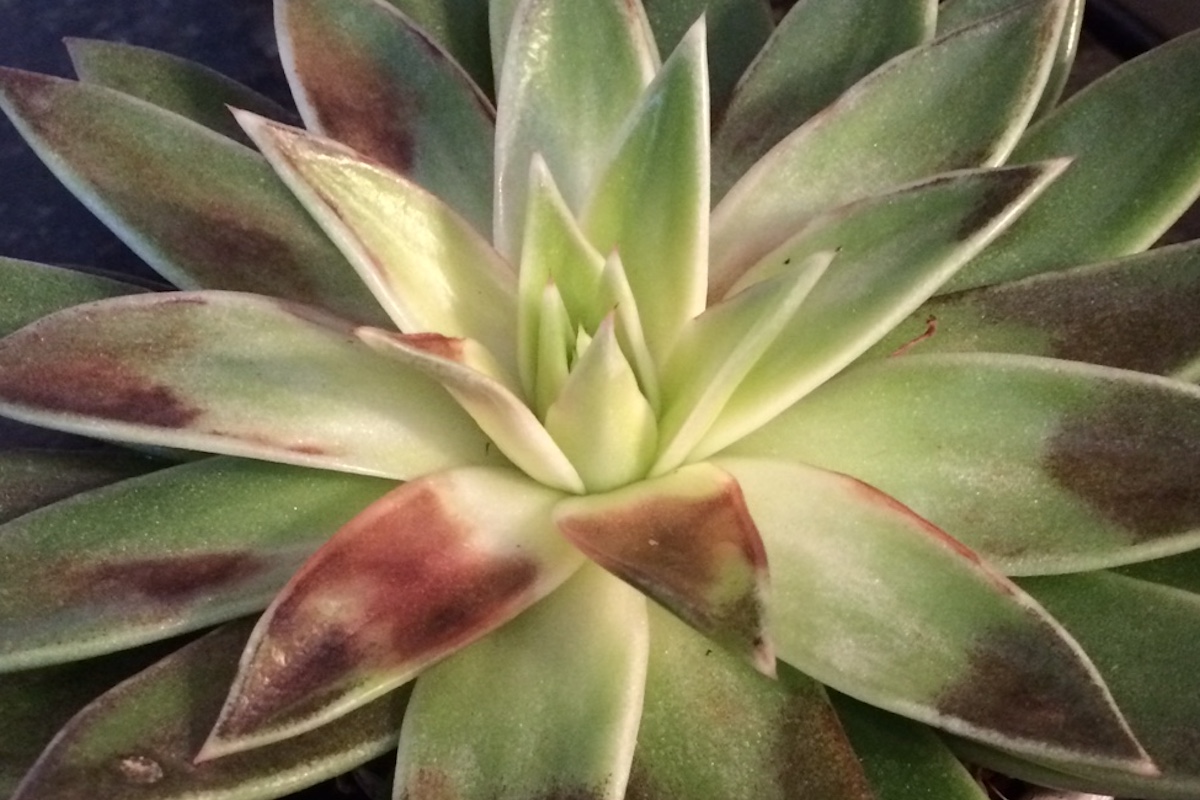
This Echeveria agavoides had too little sun followed too much, resulting in burned leaves. It should have been "hardened off," a term for gradually acclimating a plant to stressors such as greater sun exposure. See a perfectly stressed specimen in the Gallery below.
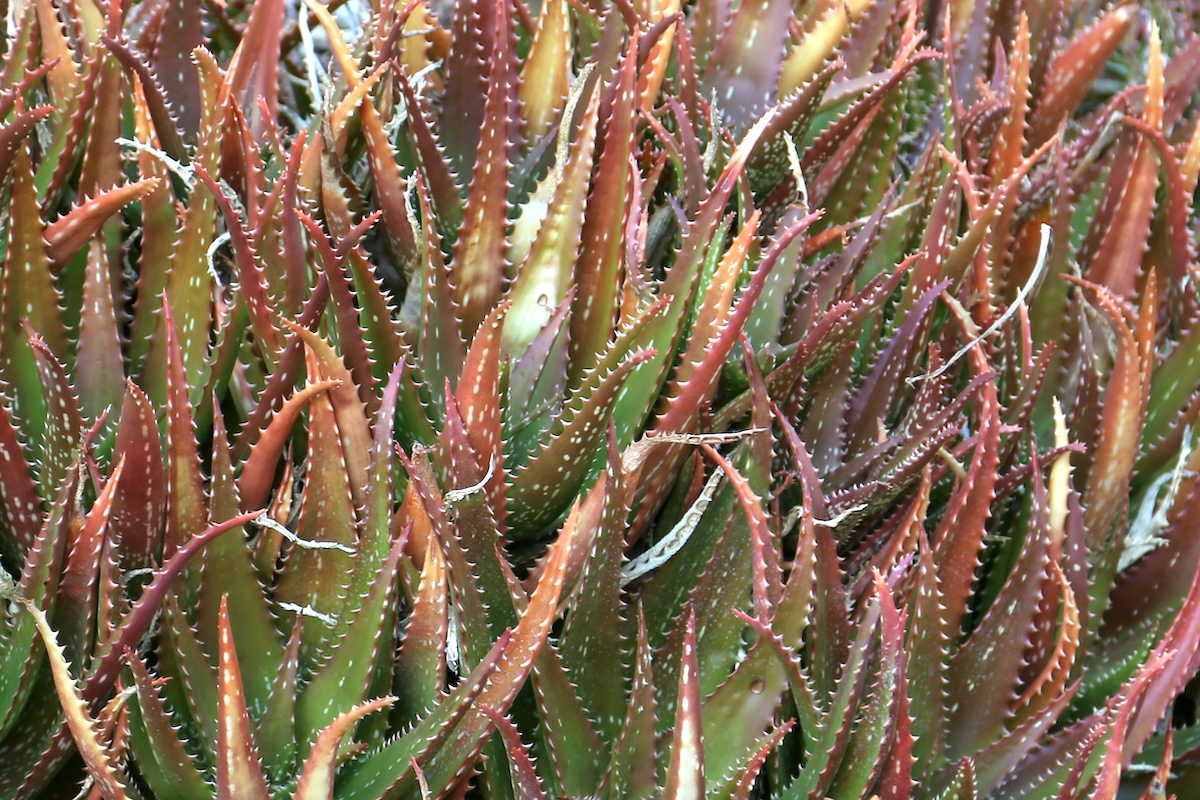
These aloes were on their way to being beautifully stressed when they became burned (beige patches). It happened after strong sun followed overcast days. Their owner could have prevented it with shade cloth, but such things are difficult to anticipate.
The importance of pigment
It's truly amazing how plants survive in the open garden, considering they have no way to head for cover. Consider: Succulents adapt to strong sunlight that would redden and blister human skin.
Just as deciduous trees turn color in autumn, sunset hues become visible in aloes and other succulents as they respond to potentially harmful amounts of sun, heat and cold.

Green (chlorophyll) gets replaced by red (anthocyanin), orange (carotene), and yellow (xanthophyll). These are comparable to melanin, the brown pigment that protects human skin from UV rays.
The art of stressing
After watching my YouTube video, "How to Stress Your Succulents...and Why You Should," a friend observed, "I'd probably stress them so much, they'd croak." Good point. How do you give a succulent a tolerable amount of stress, but not too much? And how do you know which are worth stressing, and which aren't?
Observe your plants. If leaves are margined or tipped in red, they're likely prospects. But if excess heat, sun or cold makes tips shrivel and beigey-gray patches appear on leaves, the plant is suffering. Move it to a kinder location, keep soil moist (but not soggy), and check its roots. It may be stressed in a life-threatening way because roots can't access moisture and nutrients---sometimes noticeable in cuttings that aren't snugly planted but rather sitting atop the soil.
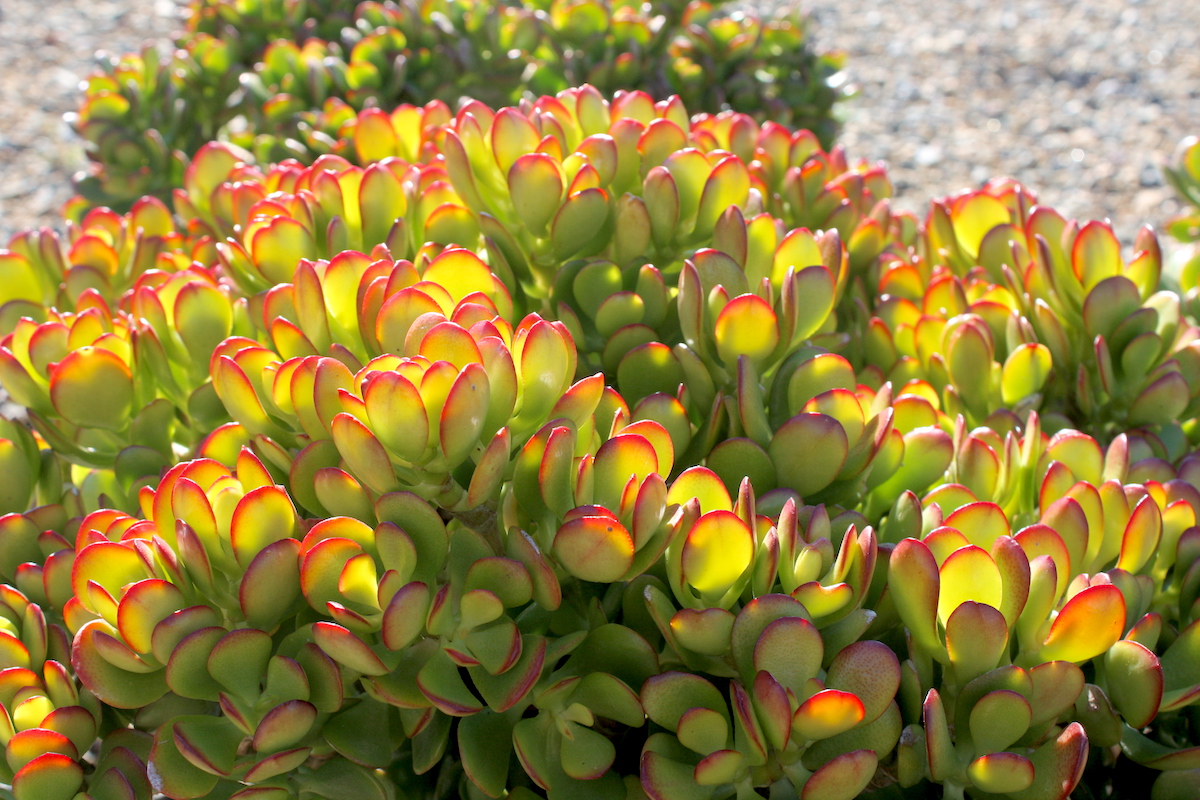
Crassula ovata (jade plant) lightly stressed
Above: Leaves of Crassula ovata (jade plant) have reddened due to less water and more cold than the plant prefers. Btw, frost will turn jade leaves to mush, but temperatures near freezing merely reddens them.
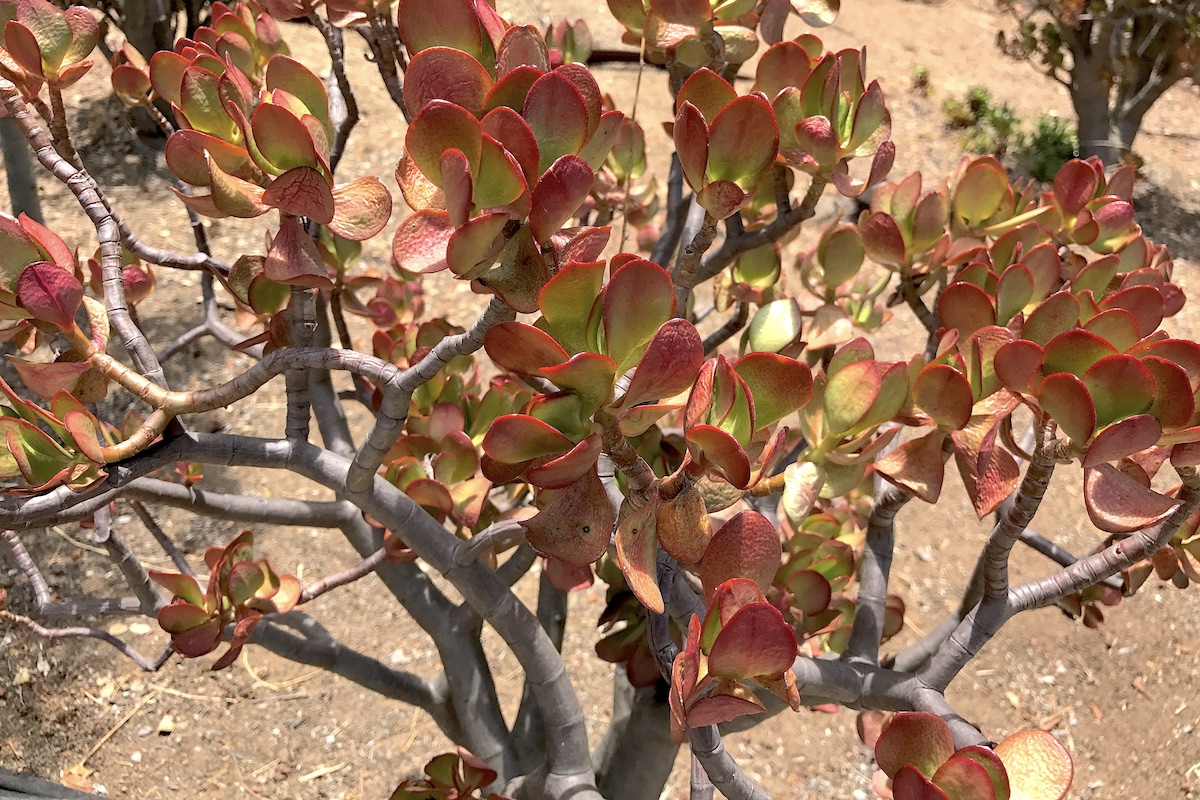
This jade plant in a neighbor's yard amazes me. It gets no water, and is so stressed by September, its leaves are shriveled. Winter rains turn them plump and green again.
When a colorful succulent turns green, it's said to "revert." This is especially noticeable with jade. Bring home a red-, yellow- or orange-leaved jade, give it too little sun, and in a few weeks it'll be green, with larger leaves and branches that have spread a bit to let in more light.
Gallery: 50+ Common succulents that redden when stressed, before and after
Related Info on this site
How Much Light Do Succulents Need?
How much light do your succulents need? It depends on the type of plant and where you live. Most haworthias and gasterias prefer shade but can handle some sun along the coast. Many but not all cacti are fine in full desert sun. As a general rule, the majority of soft-leaved succulents want half a day’s sun (in mild climates) and dappled or “bright” shade.
Red and Pink Aeoniums, Varieties and Care
I was excited to see “Carnival” Aeonium cultivars at Oasis Nursery in Escondido, CA. A spokesperson for Altman Plants (which owns Oasis) told me these pink-and-ruby beauties “are going out to garden centers as a limited item through April.” To create new hybrids striped with red, pink, cream, green, or yellow, breeders likely crossed dark…










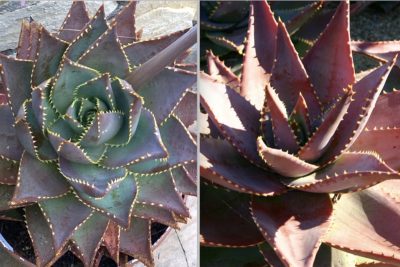




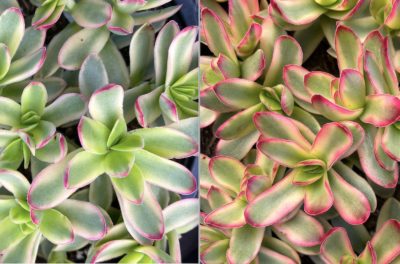







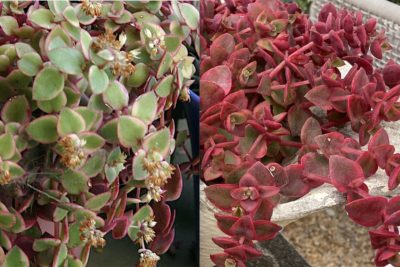









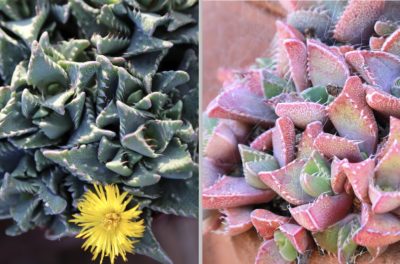







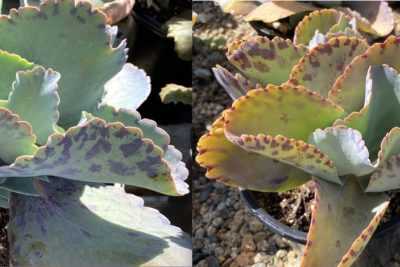








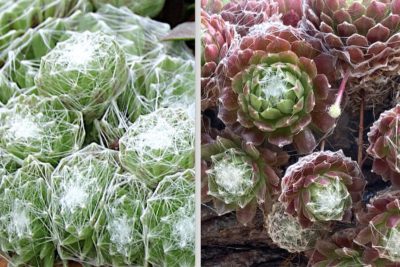
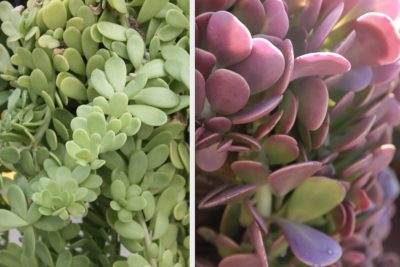


I have some large grasshoppers that I tried to catch unsuccessfully Ithink they’re eating my succulents
What can I get to get rid of them?
Hm. I also have grasshoppers as part of my garden’s natural biome, and as far as I know, they haven’t chewed my succulents. I suppose they might, but any measures taken to stop them would involve harsh pesticides that might upset the predator-pest balance. I suspect that overall, the odd grasshopper does more good than harm.
We encourage garden lizards that love to snack on grasshoppers!
how do you stress it in lowlands in a tropical country?
I’m afraid I lack expertise on regions significantly different from Southern California’s. I suggest you pursue what I’d have to, in order to help you: Check with succulent vendors and collectors in your area. If there’s a chapter of the Cactus and Succulent Society nearby, that’s a good place to start.
[…] are always green, but there are a few varieties that will turn brilliant colors when places under healthy stress. To do this, you simply need to provide them with more direct sunlight or less water. Of course, […]
[…] petite trailing succulent is beautiful in its own right, but give a little healthy stress and it will turn into an even more beautiful plant with vibrant red leaves. It is this unique look […]
Hello sir, you mention in the article that give succulent bright sunlight to achieve their colour. But actually I am living city where weather temperature is in winter min 13 & max 30°c and in summer min 25 & max 40°c. So please suggest me what can I do in winter and summer to achieve succulent colour. Please help me🙏
I have just started a succulent collection, mostly Echeveria. I am using Bonsai Jack soil, and I bottom water. How do I avoid the white fuzz, I’m guessing a mold?
Where are you located? Temperature and humidity make a difference. High humidity makes it difficult to grow succulents, especially echeverias, without rot. Fungal infestations are common in damp climates. Bottom watering is fine, but roots shouldn’t stay soggy. Don’t let the pots sit in the tray.
I live in Denver CO. How long should the pots sit in water? I read 5-10 min. I have a fan on the area where the plants are now. If I cut back the infected leaves and let it dry, will it come back or is it over! Lol? Is it better it water from the top and not get the pot or the leaves wet? I think I’m not watering anything for a couple of weeks. I have only watered every 2 weeks. Thank you so much, I’m really enjoying these little plants.
Hi Deb — Five to 10 minutes sounds about right. Insert a wood chopstick into the soil to see if wet soil clings to it when you pull it out. If rot hasn’t spread to the core of the plant, it might come back. Be sure when cutting away the damaged tissue that you get all of it. Dust clean, undamaged tissue with a fungicide that contains sulphur. Bonine is one of several. https://amzn.to/3VEMlzn
I live in Denver. I bottom water with fertilizer in the water for 5-10 min. I have been putting them outside to dry out more. I am using a fan by the shelves that they are on with the grow lights now. I will water less but the jades seem so dry. Let them suffer more? Lol. Will a plant that dries out recover? Thanks
Jades tolerate soils that are too dry or too wet (at least here in Southern CA). If a root ball has dried to the point that it’s hardened, soak it to rehydrate it.
My kalanchoe is breaking off mid stem and all its lower paddle leaves are falling off rapidly – is this normal ? How can I save my plant !?
Hi Sangeeta, It’s not normal, but you can probably salvage it by rooting the healthy top stem as a cutting. Discard the rest of the plant, soil and all.